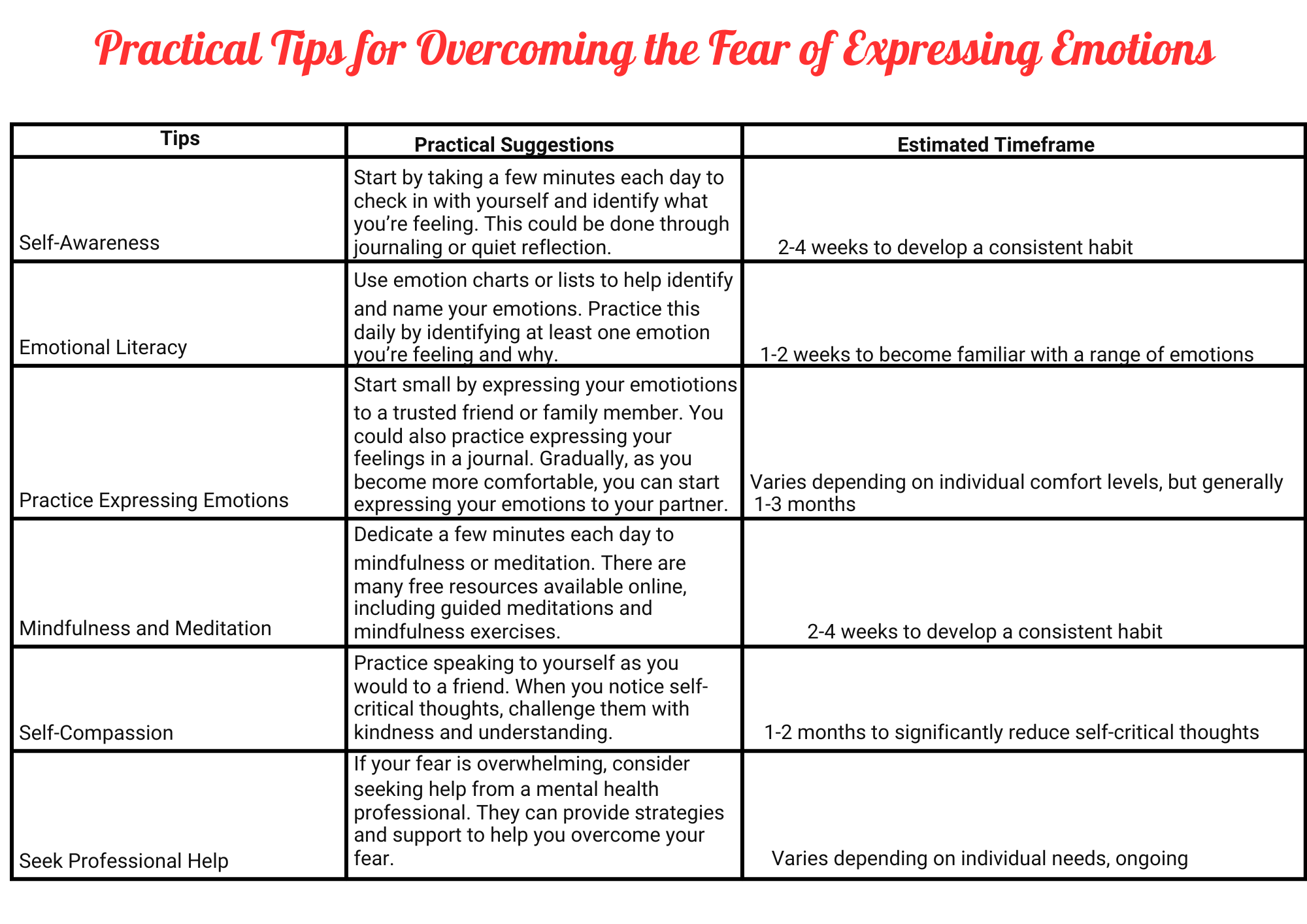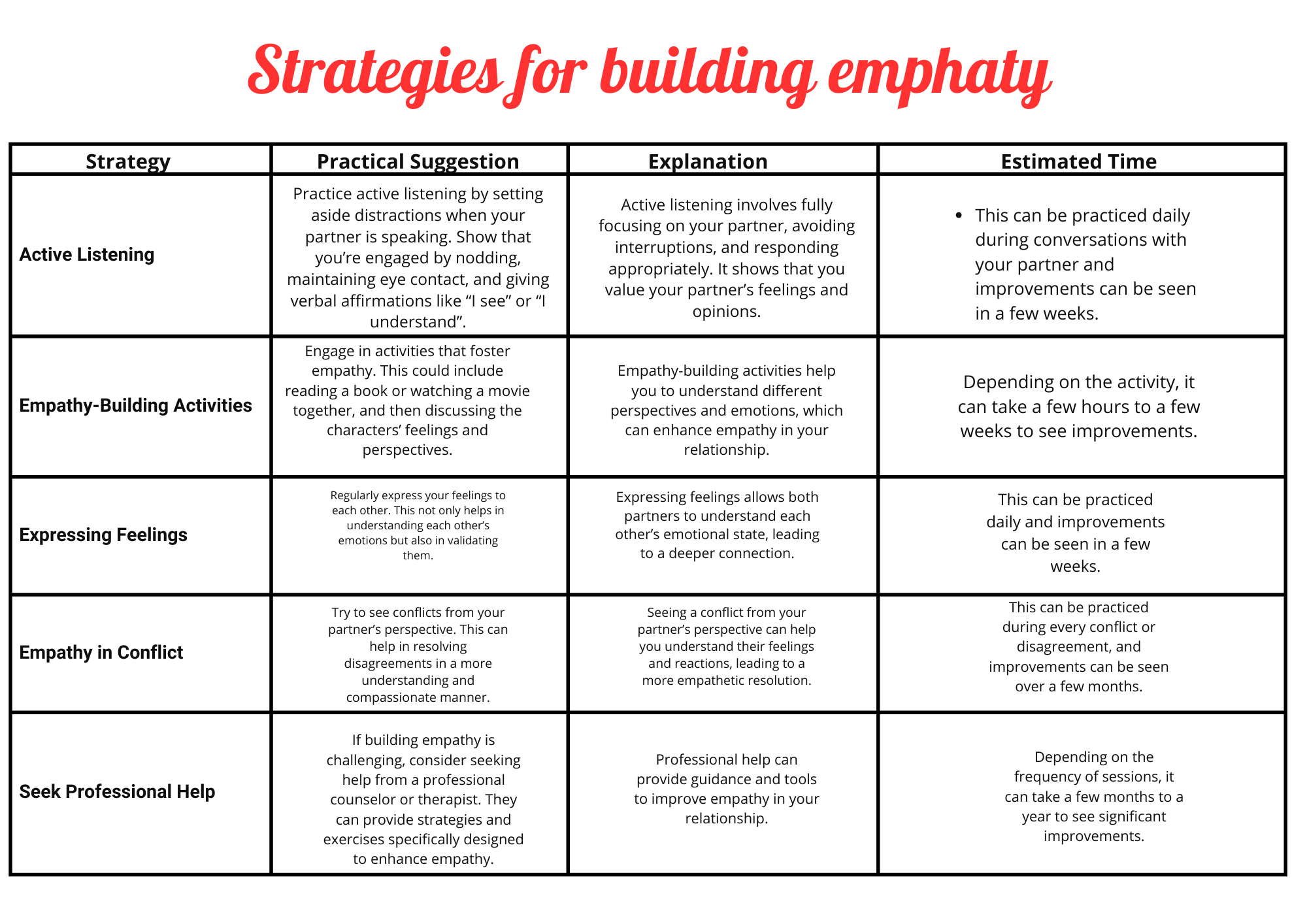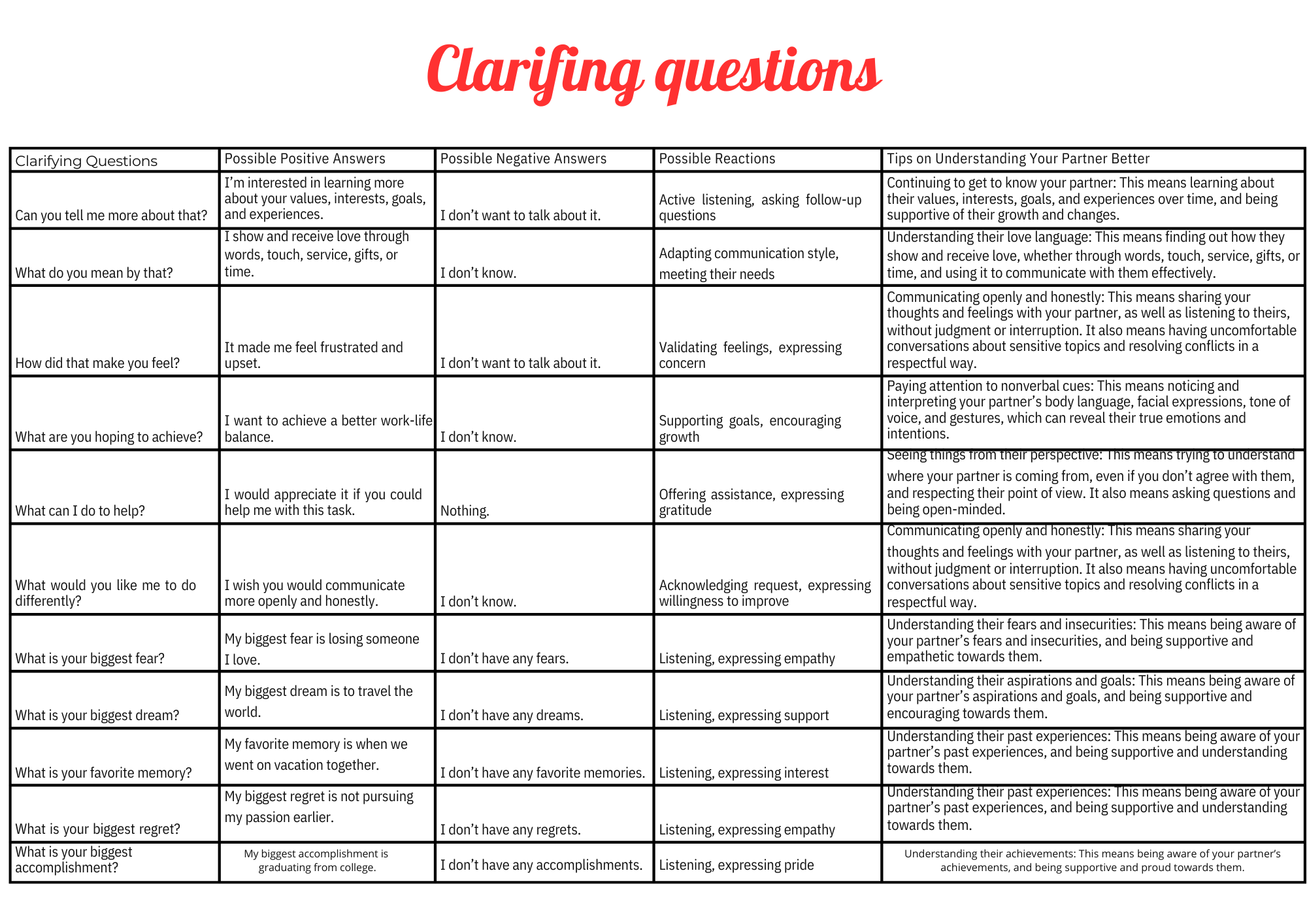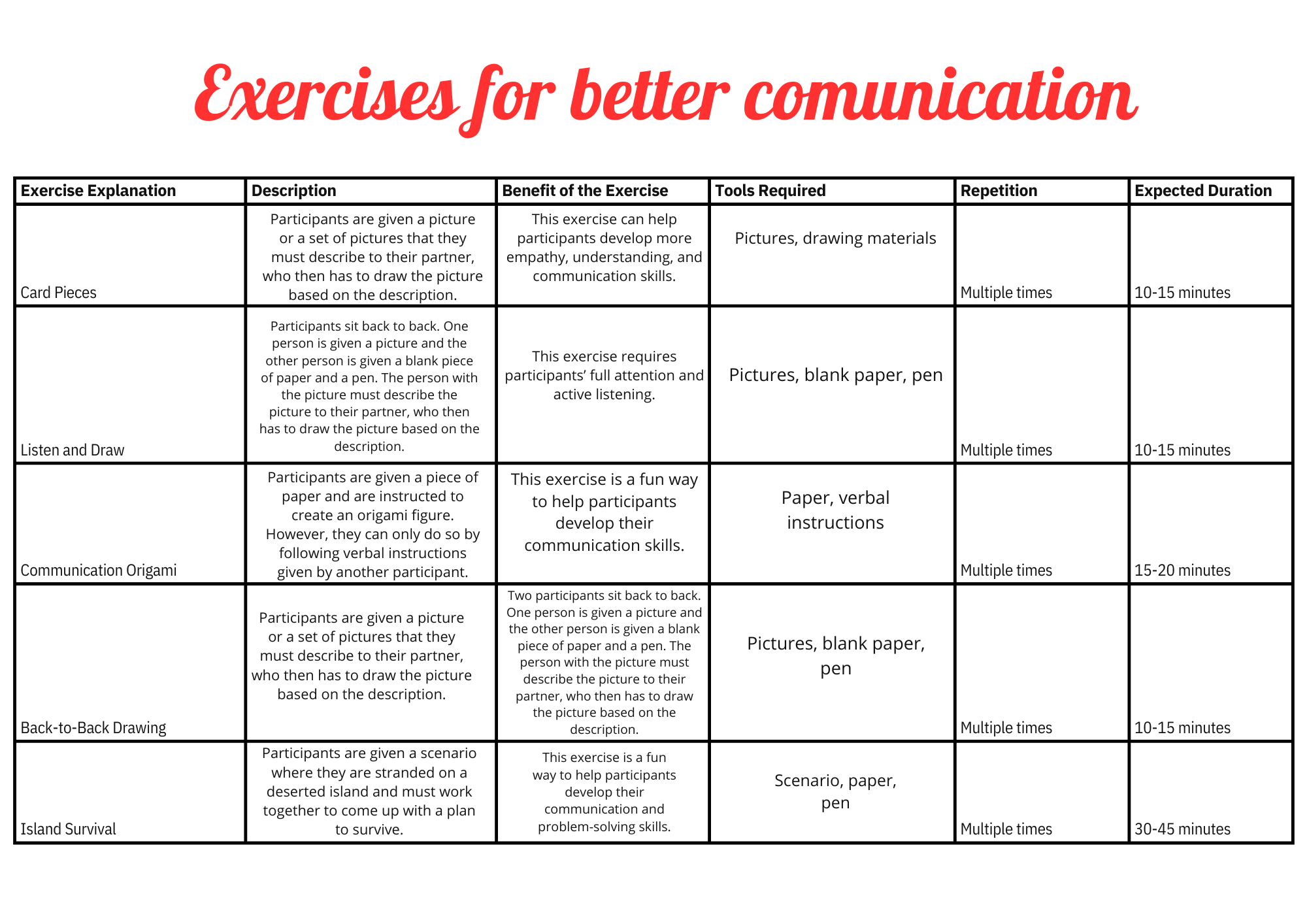how to communicate with your partner better


Step 1
Fights in Marriage: Understanding and Managing Emotions

Marriage, like any relationship, is a complex interplay of emotions, communication, and shared experiences. Disagreements are a natural part of any relationship, including marriage. However, when disagreements escalate into fights, it can strain the relationship and cause emotional distress.
The Role of Shame and Fear in Marital Breakdown
Shame in men often stems from societal and cultural expectations that dictate that men should be strong, stoic, and not show vulnerability. This can lead to a reluctance to express feelings, creating a barrier in communication within the marriage.
Men may also fear rejection or ridicule, which can further inhibit them from expressing their feelings. This fear can be particularly intense if they perceive their feelings as being out of alignment with societal norms or expectations.
Low self-esteem can also play a role in this dynamic. Men with low self-esteem may feel ashamed to express their feelings as they may anticipate criticism and feel they are unworthy. This can result in feelings of shame and a reluctance to share their emotions.
Negative core beliefs such as “I’m not good enough” or “I’m a failure” can lead to feelings of shame. These beliefs can prevent men from expressing their feelings as they fear they will be judged or rejected.
Finally, a lack of emotional literacy can also contribute to feelings of shame. Some men may not have been taught how to identify or express their emotions, leading to feelings of shame when they are unable to do so.
Women, on the other hand, may suppress their feelings out of fear. This fear could be of rejection, conflict, or even of hurting their partner. As a result, they might keep their feelings, especially negative ones, to themselves.
The fear of vulnerability can play a significant role in this dynamic. Sharing feelings requires a level of vulnerability that can be scary. Women might fear that their feelings will be dismissed, ridiculed, or used against them.
Fear of rejection is another common emotion that can prevent women from expressing their feelings. There’s a fear that if they express their true feelings, their partner might reject them or the relationship might end.
Fear of conflict can also inhibit women from expressing their feelings. Expressing feelings, especially negative ones, can lead to conflicts. Some women might fear these conflicts and choose to keep their feelings to themselves to maintain peace.
Cultural and societal expectations can also contribute to this fear. In some cultures and societies, women are taught to suppress their feelings and needs for the sake of others, which can lead to fear of expressing their feelings.
Women might also fear that expressing their feelings might hurt their partner or disrupt the harmony in the relationship. This fear can prevent them from sharing their true emotions and feelings.
Past trauma or emotional neglect can also lead to fear of expressing feelings. Women who have experienced trauma or emotional neglect in the past might fear expressing their feelings due to past negative experiences.
These unexpressed emotions can create misunderstandings, causing the other partner to perceive things that may not be accurate. Over time, this can lead to a breakdown in communication, escalating conflicts, and, in some cases, divorce.

The Importance of Recognizing and Empathizing with Hidden Emotions
Recognizing and empathizing with hidden emotions is a crucial step in resolving marital conflicts and misunderstandings. Both partners need to understand that expressing certain feelings can be difficult, and sometimes, these feelings can be misunderstood, escalating a simple disagreement into a heated argument.
Empathy plays a vital role in this process. By trying to empathize and identify with the other person, partners can gain a deeper understanding of each other’s feelings and perspectives. This understanding can help them realize how challenging it can be for their partner to express certain emotions, especially those associated with shame or fear.
Moreover, empathy can foster a safe space for open communication, where both partners feel heard and understood. It can encourage partners to express their hidden emotions without the fear of rejection, ridicule, or conflict.
In conclusion, recognizing and empathizing with hidden emotions is not just about understanding what your partner is going through. It’s about validating their feelings, fostering open communication, and ultimately, strengthening the bond of the relationship. Remember, empathy isn’t about solving problems; it’s about understanding them.

Conclusion
Hidden emotions, if left unaddressed, can create a chasm in a marriage. However, by recognizing these emotions and fostering open communication, couples can bridge this gap. Remember, it’s okay to feel and express emotions, and it’s okay to seek help. With understanding, empathy, and effort, couples can rebuild their communication, resolve their disagreements, and save their marriage.
Step 2
Understanding and Communicating with Your Spouse: A Guide to Building Stronger Relationships
Communication breakdowns can be a recurring challenge in relationships. People express difficulty in understanding and effectively communicating with their spouses. In response, strategies for improving communication, such as active listening, taking a moment to process emotions, seeking clarification, and understanding perspectives, have emerged as essential coping mechanisms.
Part One: How to Understand Your Spouse: The Power of Perspective
Understanding your spouse begins with recognizing the power of perspective. Our values, beliefs, and past experiences shape our viewpoints, leading to either conflict or intimacy in relationships. Respecting and understanding your partner’s perspective is paramount to fostering a healthy connection.
Factors Influencing Perspective in Relationships
Our perspectives in relationships are intricately woven from a tapestry of influences, each contributing to the unique lens through which we view the world. These influences can be traced back to a myriad of sources, including:
- Past Experiences:
- Impact: Past experiences hold the power to shape our beliefs and attitudes. Negative encounters can give rise to limiting beliefs that impact our present perspective in relationships.
- Education:
- Formation of Values and Rules: The values and rules we adopt often find their roots in our educational experiences. These principles become guiding forces that influence our approach to relationships.
- Cultural Background:
- Shaping Values: Growing up in a particular culture embeds specific values and rules that mold our perspective. Cultural influences contribute significantly to the way we perceive and navigate relationships.
- Preconceived Notions:
- Influence on Perception: Preconceived notions, whether conscious or subconscious, play a role in shaping our perspective. These notions can impact how we interpret actions and communicate with our partners.
- Present Circumstances:
- Emotional State: Our emotional state in the present moment can color our perspective. Whether happy, sad, angry, or anxious, our emotions influence how we perceive and respond to our partner.
Recognizing these diverse influences is pivotal in understanding our own perspective and that of our spouse. It’s a dynamic process that requires self-awareness and a willingness to explore the roots of our beliefs. Awareness of these factors empowers us to make intentional choices, fostering positive change and creating a more fulfilling relationship.
Benefits of Seeing Another Point of View
Embrace the benefits of seeing your partner’s perspective, including enhanced emotional intelligence, deepened intimacy, conflict reduction, and an expanded reality. These advantages underscore the transformative impact of understanding and valuing different viewpoints, fostering personal and relational growth.
- Enhance Emotional Intelligence:
- Empathetic Connection: Seeing another point of view fosters empathy, a cornerstone of emotional intelligence. This skill not only enhances your understanding of your partner’s emotions but also contributes to personal and professional success.
- Deepen Intimacy:
- Understanding on a Deeper Level: Delving into your partner’s feelings, beliefs, and needs deepens the level of understanding in the relationship. This, in turn, makes your partner feel more valued and secure, laying the foundation for a stronger and more intimate connection.
- Reduce Conflict:
- Effective Communication: The ability to see another point of view is a potent antidote to misunderstandings, judgments, and arguments. By embracing your partner’s perspective, you can navigate disagreements more effectively and communicate with greater respect, reducing the potential for damaging conflicts.
- Expand Your Reality:
- Enriching Perspectives: Each person brings a unique set of experiences, insights, and perspectives to a relationship. By seeing another point of view, you open the door to a wealth of learning from your partner’s life journey. This expansion of perspectives enriches your own vision of the world, fostering personal growth and a broader understanding of diverse realities.
“Master the Art of Reading Your Partner’s Mind: Learn How to Decode Nonverbal Cues!” 💭

Paying attention to nonverbal cues is another important aspect of understanding your partner better. Nonverbal cues include body language, facial expressions, tone of voice, and gestures, which can reveal your partner’s true emotions and intentions 1. Here are some tips on how to pay attention to nonverbal cues in a relationship:
- Be present and attentive: This means focusing on your partner and giving them your undivided attention, both verbally and non-verbally. It also means resisting the urge to interrupt or offer solutions, and simply allowing your partner the space to express themselves .
- Notice patterns and changes: This means observing your partner’s nonverbal cues over time and looking for patterns or changes that may indicate their mood or feelings. For example, if they usually make eye contact but avoid it now, or if they usually smile but frown now, it may be a sign that something is wrong .
Here are some patterns and changes in nonverbal cues that may indicate mood or feelings:
- Facial expressions: A furrowed brow, a downturned mouth, or a clenched jaw may indicate anger, frustration, or sadness. A smile, a raised eyebrow, or a relaxed face may indicate happiness, interest, or curiosity.
- Eye contact: Avoiding eye contact, staring, or blinking rapidly may indicate discomfort, anxiety, or dishonesty. Maintaining eye contact, looking away briefly, or blinking normally may indicate confidence, trust, or respect.
- Posture: Slouching, crossing arms, or fidgeting may indicate defensiveness, insecurity, or boredom. Sitting up straight, leaning forward, or gesturing may indicate engagement, enthusiasm, or openness.
- Gestures: Clenched fists, crossed legs, or tapping fingers may indicate impatience, frustration, or anger. Open palms, relaxed limbs, or nodding may indicate agreement, relaxation, or interest.
- Tone of voice: Speaking loudly, quickly, or harshly may indicate anger, aggression, or impatience. Speaking softly, slowly, or warmly may indicate calmness, kindness, or intimacy.
By paying attention to these patterns and changes in nonverbal cues, you can gain a deeper understanding of your partner’s emotions and intentions, and respond accordingly. Remember to avoid making assumptions or judgments, and instead try to understand your partner’s perspective and feelings.
- Ask clarifying questions: This means asking your partner questions to clarify their nonverbal cues and show that you care about their feelings. For example, you can ask “Are you feeling upset?” or “Is there something on your mind?”.
Here are the top 11 clarifying questions that can help you understand your partner better:

- Avoid assumptions and judgments: This means avoiding jumping to conclusions or making assumptions about your partner’s nonverbal cues, as they may have different meanings for different people. It also means avoiding judging your partner’s nonverbal cues as good or bad, right or wrong, and instead trying to understand them from their perspective
Part Two: Mastering the Art of Communication with Your Spouse

In the symphony of love, communication is the conductor that orchestrates connection, understanding, and lasting joy. This section is your compass to navigate the intricate world of relationship communication. Brace yourself for insights, tips, and exercises as we unveil the secrets to enriching your connection with your spouse. Get ready to embark on a transformative adventure towards deeper understanding, love, and unbreakable bonds! 🌟🗝️
Healthy Communication: Strategies for Maintaining a Strong Connection
Healthy communication is a crucial aspect of any relationship, especially in a couple’s relationship. It helps build trust, intimacy, and mutual respect. In this section, we will discuss what healthy communication is, constructive strategies for healthy communication, and strategies to keep things interesting.
What is healthy communication?
According to the American Psychological Association, healthy communication involves talking openly, using constructive strategies, and keeping things interesting. Talking openly means making time to check in with your partner on a regular basis and discussing deeper or more personal subjects to stay connected over the long term.
Constructive strategies involve listening to your partner’s point of view, understanding their feelings, and avoiding negative communication patterns like yelling or personal criticisms. Keeping things interesting involves planning regular date nights, trying new things together, and spending time apart.
Constructive strategies for healthy communication
Here are some constructive strategies for healthy communication in couple relationships:
Listen actively: Pay full attention to what your partner says, stop and listen, and take note of your communication style. Develop non-verbal skills and keep a tab of the negative non-verbal cues .
Be honest: Be truthful and transparent with your partner. Avoid hiding things from them, as this can lead to a lack of trust and misunderstandings .
Validate your partner’s feelings: Acknowledge and repeat back some of what your partner said. This helps them feel heard and understood .
Ask questions: Try to understand your partner’s perspective by asking questions. This helps you avoid making assumptions and jumping to conclusions.
Avoid negative communication patterns: Couples that use destructive behavior during arguments — such as yelling, resorting to personal criticisms or withdrawing from the discussion — are more likely to break up than are couples that fight constructively. Using constructive strategies like listening to your partner’s point of view and understanding their feelings is a healthier way to deal with disagreements .
Strategies to keep things interesting
Here are some strategies to keep things interesting in a couple’s relationship:
- Plan regular date nights: Even if you have busy schedules, try to make time for each other. Plan regular date nights and try new things together. This can be as simple as trying a new restaurant or going on a day trip to a place you’ve never been before.
- Surprise each other: Surprise your partner with little things like a thoughtful note, a small gift, or a surprise visit to their workplace. This can help keep the spark alive and show your partner that you care.
- Try new things together: Trying new things together can be a fun way to connect and keep things interesting. It can be as simple as taking a class together, going dancing, or packing an afternoon picnic.
- Spend time apart: Spending time apart can help you appreciate the time you spend together. It can also give you time to pursue your own interests and hobbies 4.
- Be vulnerable: Being vulnerable with your partner can help you build trust and intimacy. Share your thoughts, feelings, and fears with your partner. This can help you feel more connected and supported .
What to Do if There’s No Communication in a Relationship
Identifying the Root Causes of Communication Breakdown in Couples
Some of the most common causes of communication breakdown in couples include:
- Balancing busy schedules and stresses
- Trust issues
- External traumas
- Assuming that communication is just sending a message
- Generational, language, location, emotional, attention to details, confidence, poor listening, perception, industry jargon, lack of training, cultural differences, disabilities, non-verbal cues, and bad attitudes barriers
To identify the root causes of communication breakdown in your specific situation, it’s important to take a step back and assess the situation.
Consider the context of the communication breakdown, the people involved, and the specific issues that are causing the breakdown. Once you have identified the issues, it’s important to express your feelings and needs to your partner.
Listening empathically is also crucial to effective communication. Seeking professional help can be a valuable step towards healing and understanding if the communication breakdown persists.
The Best Ways to Address Communication Breakdown in Couples
here are some steps you can take to address communication breakdowns:
- Observe: Take a step back and observe how you and your partner communicate with each other. Identify the patterns and behaviors that are causing the communication breakdown.
- Listen: Listening empathically is crucial to effective communication. Make sure you’re giving your partner your full attention and actively listening to what they have to say.
- Express your feelings and needs: Once you have identified the issues, it’s important to express your feelings and needs to your partner. Use “I” statements to avoid sounding accusatory.
- Compromise: Make compromising and resolution the goal. Work together to find a solution that works for both of you.
- Set clear boundaries: Set clear boundaries and expectations for communication. This can help prevent future communication breakdowns.
Resources to Help Improve Communication Skills
Here are some resources that can help you improve your communication skills:
- Communication exercises: Healthy communication exercises for couples can help partners figure out how to strengthen their romantic relationship. Here, you can learn more about the importance of relationship communication exercises and get examples of some of our favorite communication activities to practice connecting with your romantic partner on a deeper level.
Here’s a table with some of the exercises:

- Couples counseling books: There are many books available that can help you improve your communication skills and build a stronger relationship with your partner. For example, “Hold Me Tight” by Dr. Sue Johnson is a popular book that provides practical advice and exercises for couples looking to improve their communication skills.
Remember, communication is the foundation of any healthy relationship. By taking proactive steps to improve your communication skills, you can build a stronger, more fulfilling relationship with your partner.
Defensive Communication in a Couple: How to Spot It and Address It
Sometimes it can be difficult to communicate effectively with your partner.
One common issue that couples face is defensive communication. This occurs when one or both partners become defensive during a conversation, which can lead to misunderstandings, hurt feelings, and even conflict.
Here are some tips to help you spot defensive communication in your relationship:
- Denial: One of the most common signs of defensive communication is denial. The person may deny that they said or did something, or they may deny that they have a problem.
- Blame: Another sign of defensive communication is blame. The person may blame their partner for the problem, or they may blame someone or something else.
- Criticism: Defensive communication can also involve criticism. The person may criticize their partner or others as a way of deflecting attention away from themselves.
- Contempt: Contempt is another sign of defensive communication. The person may show contempt for their partner or others as a way of making themselves feel better.
- Stonewalling: Stonewalling is when a person shuts down and refuses to communicate. This is a common sign of defensive communication.
- Avoidance: Avoidance is another sign of defensive communication. The person may avoid certain topics or conversations as a way of protecting themselves.
- Deflection: Deflection is when a person changes the subject or avoids answering a question. This is another common sign of defensive communication.
If you notice any of these signs in your relationship, it’s important to address them. Here are some tips to help you communicate more effectively with a defensive partner:
- Use “I” statements: When sharing your feelings with a defensive partner, consider using “I” statements instead of “you” statements. This can help prevent your partner from feeling attacked and becoming more defensive. For example, instead of saying “You never listen to me,” you could say “I feel unheard when you interrupt me.”
- Stay calm: Try to stay calm and avoid getting angry or frustrated. This can help keep the conversation from escalating into an argument.
- Repeat yourself: If your partner doesn’t seem to be listening or understanding what you’re saying, try repeating yourself in a calm and patient manner.
- Be specific: Be specific about what you’re upset about and why. This can help your partner understand your perspective and avoid becoming defensive.
- Listen actively: Make sure you’re actively listening to your partner and trying to understand their perspective. This can help prevent misunderstandings and defensiveness.
One effective way to communicate with a defensive partner is to use “I” statements. This means framing the effects of a situation around your personal experience, not on what the other person did wrong.
For example, instead of saying “You’re always interrupting me,” you could say “I feel unheard when I’m interrupted.”
This can help prevent your partner from feeling attacked and becoming more defensive.
Here are 7 examples of “I” statements that you can use in a discussion:
- “I feel hurt when you don’t listen to me.”
- “I get frustrated when I feel like my opinions aren’t being heard.”
- “I feel disrespected when you interrupt me.”
- “I feel ignored when you spend more time on your phone than talking to me.”
- “I feel upset when you raise your voice at me.”
Remember to stay calm and patient, and to actively listen to your partner’s perspective as well. With effort and commitment from both partners, it’s possible to improve communication and overcome defensive behaviors.
The Role of Past Traumas in Defensive Communication

Past traumas can have a significant impact on how we communicate with others, particularly in close relationships.
Traumatic experiences such as abuse, neglect, or violence can lead to feelings of fear, anxiety, and insecurity, which can in turn trigger defensive behavior in a relationship.
For example, a person who has experienced emotional abuse in the past may become defensive when their partner raises their voice, even if the partner is not being abusive.
Other examples of past traumas that can trigger defensive behavior include:
- Childhood trauma: Traumatic experiences in childhood, such as physical or emotional abuse, can have a lasting impact on a person’s ability to communicate effectively in relationships.
- Betrayal: Betrayal by a partner, such as infidelity, can lead to feelings of mistrust and defensiveness.
- Loss: The loss of a loved one can trigger feelings of grief and sadness, which can make it difficult to communicate effectively with a partner.
It’s important to approach the situation with empathy and understanding, and to avoid blaming or attacking your partner. By working together and seeking professional help if necessary, you and your partner can overcome defensive communication and build a stronger, healthier relationship.
CONCLUSION:
Ever wondered why your “I do” now feels like “I don’t know”? Relationships can be like puzzles, right? Ever feel like you’re talking but not being heard? It’s tough when you’re trying hard but still hitting a brick wall. Guess what? You’re not alone, and there’s a fix!
Let’s cut to the chase. Communication is the secret sauce. It’s not just about talking; it’s about understanding. Think of it as a two-way street. You talk, they listen. They talk, you listen. Simple, but not always easy.
First off, see things from their shoes. Everyone’s got a story, and it shapes how they think and feel. Know their story, and you’re halfway there. It’s like unlocking a secret code to their heart.
Then, listen. Really listen. Not just to words, but to what’s not being said. The sighs, the pauses, the eye rolls. They’re clues to what’s really going on.
Got something to say? Say it straight. No beating around the bush. But here’s the key: do it without pointing fingers. Talk about how you feel, not what they did wrong. It’s like saying, “Here’s my side of the story,” without stepping on their toes.
Stuck in a rut? Shake things up. Try new things together. Keep the spark alive. It’s like adding spice to your favorite dish.
And if things get rocky? Don’t just stand there. Step up and sort it out. Ask questions, get to the heart of the matter. It’s like being a detective in your own love story.
Remember, it’s about teamwork. You’re in this together, building something awesome. With each word, each gesture, you’re laying down bricks for a stronger bond.
So, ready to turn things around? Roll up your sleeves and dive in. Your relationship’s waiting for a makeover, and you’ve got the tools to do it!